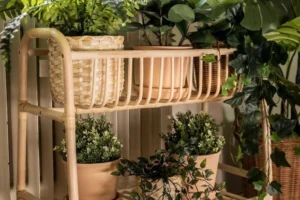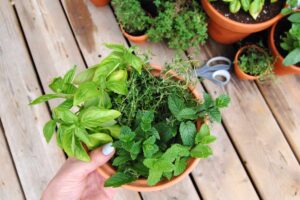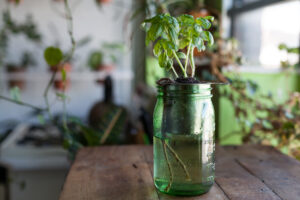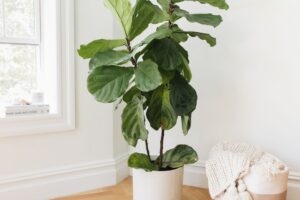10 Stunning Types of Calathea Plants: The Complete Guide
Are you looking to bring a touch of tropical elegance to your home? Calathea plants, with their striking patterns and vibrant colors, might be exactly what you need. These stunning houseplants, native to the tropical Americas, have gained immense popularity in the US market for their ornamental foliage and air-purifying qualities.
In this comprehensive guide, we’ll explore ten of the most breathtaking Calathea varieties that can transform your living space. Whether you’re a seasoned plant parent or just beginning your indoor gardening journey, these attention-grabbing beauties deserve a special place in your collection.
Understanding Calathea Plants: Nature’s Living Art
Before diving into specific varieties, let’s understand what makes Calathea plants so special. Belonging to the Marantaceae family, these tropical understory plants are renowned for their distinctively patterned leaves. The United States Department of Agriculture (USDA) classifies most Calathea plants in zones 10-11, indicating their preference for warm, humid conditions typical of their native rainforest habitats. You can learn more about tropical plant classifications on the USDA Plant Hardiness Zone Map.
What truly sets Calathea plants apart is their nyctinastic movement – a fascinating phenomenon where leaves fold up at night and unfurl in the morning, earning them the nickname “prayer plants.” This natural rhythm, responding to light changes, mimics the behavior of their close relatives in the Maranta genus.
In recent years, some botanical classifications have moved many Calathea species to the Goeppertia genus based on genetic studies. However, in the horticultural world and US market, they continue to be commonly known as Calatheas. Throughout this article, we’ll use the names most familiar to home gardeners.
Calathea Care Basics: Setting You Up for Success
Before exploring specific varieties, understanding these fundamental care requirements will help you provide the optimal environment for any Calathea in your collection:
Calatheas thrive in bright, indirect light. Direct sunlight can fade their vibrant patterns and scorch their delicate leaves. An east or north-facing window offers ideal lighting conditions for these shade-loving beauties. If you only have access to brighter exposures, a sheer curtain can provide the necessary filtering.
The soil composition plays a crucial role in Calathea health. These plants prefer a well-draining, aerated mix that retains some moisture without becoming waterlogged. A quality indoor potting mix amended with perlite, orchid bark, and a small amount of coco coir creates the perfect balance for their roots to thrive.
Maintaining consistent humidity levels above 50% significantly impacts Calathea well-being. In the drier climate of many US homes, especially during winter heating seasons, you’ll need to implement humidity-boosting strategies. Grouping plants together, using pebble trays, or investing in a humidifier can create the moisture-rich environment these tropical plants crave.
Watering practices require careful attention with Calatheas. They prefer soil that stays evenly moist but never soggy. Allow the top inch of soil to dry before watering thoroughly, ensuring excess water drains completely. Using filtered or distilled water at room temperature prevents the leaf discoloration often caused by fluoride, chlorine, and other chemicals in tap water.
Temperature stability between 65°F and 85°F (18°C to 29°C) provides optimal growing conditions. Protect your Calathea from drafts, sudden temperature fluctuations, and heating/cooling vents that can stress the plant and lead to curling leaves.
Fertilizing should be approached with moderation. During the growing season (spring through early fall), apply a balanced, water-soluble fertilizer diluted to half the recommended strength once a month. Reduce or eliminate fertilization during the dormant winter months.
Now that we’ve covered the fundamental care requirements, let’s explore ten spectacular Calathea varieties that showcase the remarkable diversity within this plant genus.
1. Calathea Orbifolia: The Statement Piece
Calathea orbifolia stands as perhaps the most instantly recognizable member of the Calathea family. With its large, round leaves featuring dramatic silver and green striping, this variety makes an undeniable statement in any room. Native to Bolivia, the orbifolia has become increasingly available in the US market over the past decade, though it remains somewhat more expensive than other varieties due to its slower growth rate and higher demand.
What makes the orbifolia particularly special is the extraordinary width of its leaves, which can reach up to 12 inches in diameter when grown in optimal conditions. The silvery bands that alternate with deep green create an almost hypnotic pattern that seems to glow in filtered light. This distinctive appearance has made it a favorite among interior designers and plant enthusiasts seeking dramatic focal points for living spaces.
While visually stunning, the orbifolia demands slightly more attention than some other Calathea varieties. Its large leaves are particularly sensitive to mineral buildup from tap water, often developing brown edges when exposed to fluoride or chlorine. To keep those magnificent leaves in pristine condition, you’ll want to use distilled or rainwater and maintain higher humidity levels than required for most houseplants.
When properly cared for, an orbifolia can reach impressive dimensions, growing up to 2.5 feet tall and wide. Its upright growth habit and symmetrical form eliminate the need for frequent pruning, allowing you to enjoy its architectural presence with minimal maintenance beyond standard care.
Decorating with Calathea Orbifolia
The orbifolia’s dramatic scale and pattern make it ideal for:
Modern minimalist spaces where its bold leaves provide organic texture against clean lines and neutral colors.
Bathrooms with sufficient indirect light, where naturally higher humidity levels help the plant thrive while adding tropical spa-like ambiance.
Home offices, where studies suggest that visually complex natural elements like the orbifolia’s patterned foliage can boost creativity and reduce stress levels.
Placed in a simple pot that complements without competing with its striking foliage, the orbifolia can transform an ordinary corner into a sophisticated botanical display that captures attention without overwhelming the space.
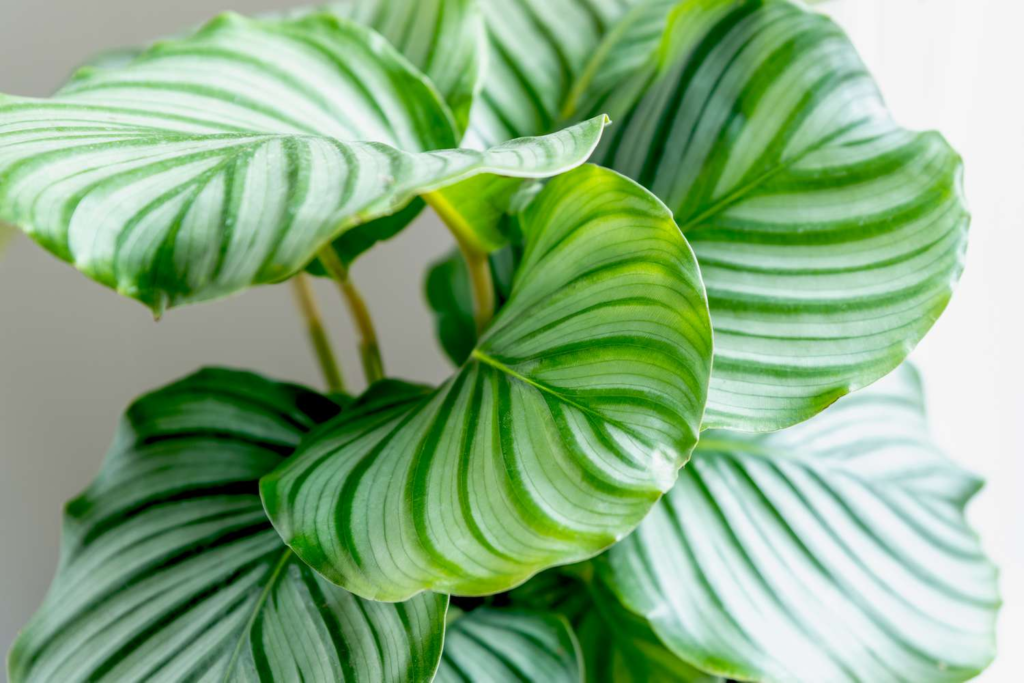
2. Calathea Medallion: The Colorful Masterpiece
If you’re seeking a Calathea that incorporates a broader spectrum of colors, the Calathea medallion (Calathea veitchiana) delivers with its breathtaking palette. Each leaf presents a masterpiece of natural artistry with deep green surfaces, feathered with lighter green patterns, burgundy undersides, and distinct purple stems.
The medallion’s round to oval leaves feature a distinctive central silver-green “medallion” pattern surrounded by darker green edging, creating a high-contrast effect that draws the eye. This visual complexity makes it one of the most photographed Calatheas on social media platforms, where its photogenic qualities have contributed to its rising popularity in the US market.
What many new plant owners appreciate about the medallion is its relatively faster growth rate compared to some other Calathea varieties. Under favorable conditions, you can expect to see new leaves emerging throughout the growing season, each unfurling to reveal increasingly intricate patterns as the plant matures.
The medallion grows in a more clustered, bushy formation than the orbifolia, typically reaching 1-2 feet in height and spread. This compact growth habit makes it suitable for smaller spaces while still providing significant visual impact.
Though slightly more forgiving of lower humidity than some other varieties, the medallion still demonstrates its displeasure with dry conditions through curling leaves. Implementing consistent humidity-boosting measures will reward you with the flattest, most vibrantly patterned foliage.
Seasonal Changes in Calathea Medallion
One fascinating aspect of the medallion is how its appearance shifts subtly with the seasons. During periods of active growth, new leaves often display more vibrant coloration, with deeper burgundy undersides and more pronounced pattern definition. As light levels decrease in winter, the contrast between the central medallion pattern and surrounding green may become more subtle.
This seasonal variation adds another dimension to the plant’s appeal, allowing you to observe its dynamic response to changing environmental conditions throughout the year. Documenting these changes through photographs provides a rewarding record of your plant’s development and your success as its caretaker.

3. Calathea Roseopicta ‘Dottie’: The Dramatic Contrast
For those who prefer a more dramatic color palette, Calathea roseopicta ‘Dottie’ offers perhaps the most striking contrast in the Calathea family. This cultivar features deep purple-black leaves accented with vibrant pink outlines and markings. The high contrast between the dark base color and bright accents creates a visual effect that seems almost artificially enhanced but is entirely natural.
What makes ‘Dottie’ particularly special is how the coloration changes as leaves mature. New growth emerges with a lighter, more prominent pink pattern that gradually intensifies in contrast as the leaf darkens to its characteristic deep purple-black. This developmental transformation adds a dynamic element to the plant’s appearance, with different leaves displaying varying stages of this color evolution.
In recent years, ‘Dottie’ has become increasingly sought-after in the US market, particularly among collectors who specialize in dark-leaved houseplants. Its popularity has spawned numerous styling trends on social media, where its gothic elegance pairs surprisingly well with both minimalist and maximalist design aesthetics.
At maturity, ‘Dottie’ remains relatively compact, typically reaching 12-20 inches in height and spread. This manageable size makes it ideal for tabletop displays, plant shelves, or anywhere you want to add a dramatic color accent without overwhelming the space.
One important consideration with ‘Dottie’ is light exposure. While all Calatheas require protection from direct sunlight, finding the right balance is particularly crucial with this dark-leaved variety. Too little light will prevent the development of its characteristic deep coloration, while too much can cause fading of the distinctive pink markings. An east-facing window often provides the ideal balance for developing its full color potential.
The Science Behind ‘Dottie’s’ Dramatic Coloration
The intense purple-black coloration in ‘Dottie’ results from high concentrations of anthocyanin pigments in the leaf tissues. These same compounds are responsible for the purple coloration in many edible plants with nutritional benefits. In Calatheas, these pigments likely evolved as protection against light damage in their native understory habitats.
Research from the USDA Agricultural Research Service has explored how various environmental factors affect anthocyanin development in plants, noting that controlled stress (such as slightly higher light levels than typically recommended for shade plants) can sometimes intensify coloration without harming overall plant health. You can learn more about plant pigmentation research at the USDA ARS website.

4. Calathea Lancifolia (Rattlesnake Plant): The Wild Pattern
The Calathea lancifolia, commonly known as the Rattlesnake Plant, breaks from the rounded leaf pattern of many Calatheas with its distinctive elongated, wavy-edged leaves. These narrow, lance-shaped leaves feature a bold pattern of alternating light and dark green ovals atop a lighter background, while the undersides display a rich purple hue.
What makes the Rattlesnake Plant particularly appealing to many indoor gardeners is its reputation as one of the more adaptable and forgiving Calathea varieties. While it still appreciates high humidity and consistent moisture, it tends to be slightly more tolerant of average household conditions than some of its more demanding cousins.
The lancifolia’s unique growth habit also sets it apart from other Calatheas. Rather than forming a tight, compact cluster, it tends to grow in a more open, fountaining pattern with leaves radiating outward from the center. This architectural quality creates dramatic shadows and light play when positioned near a window with filtered light.
Native to the rainforests of Brazil, the Rattlesnake Plant has adapted remarkably well to indoor cultivation across various regions of the United States. Its ability to thrive in a wider range of conditions has contributed to its consistent popularity in the US market, where it’s often recommended as an excellent “starter Calathea” for those just beginning to explore this fascinating genus.
At maturity, the lancifolia typically reaches 24-30 inches in height, with individual leaves growing up to 18 inches long. This vertical growth habit makes it an excellent choice for adding height to plant groupings or filling narrower spaces where wider-spreading varieties might overwhelm the area.
Historical Significance of the Rattlesnake Plant
Before becoming a popular houseplant, Calathea lancifolia held significant cultural importance in its native regions. Indigenous communities in Brazil traditionally used the large leaves for food wrapping and preservation, taking advantage of the natural plant compounds that helped protect food from spoilage.
This practical application speaks to the remarkable adaptability of the species, which developed natural antimicrobial properties as an evolutionary advantage. These same resilient characteristics contribute to its success as a houseplant today, as it demonstrates slightly stronger resistance to pest issues than some other Calathea varieties.
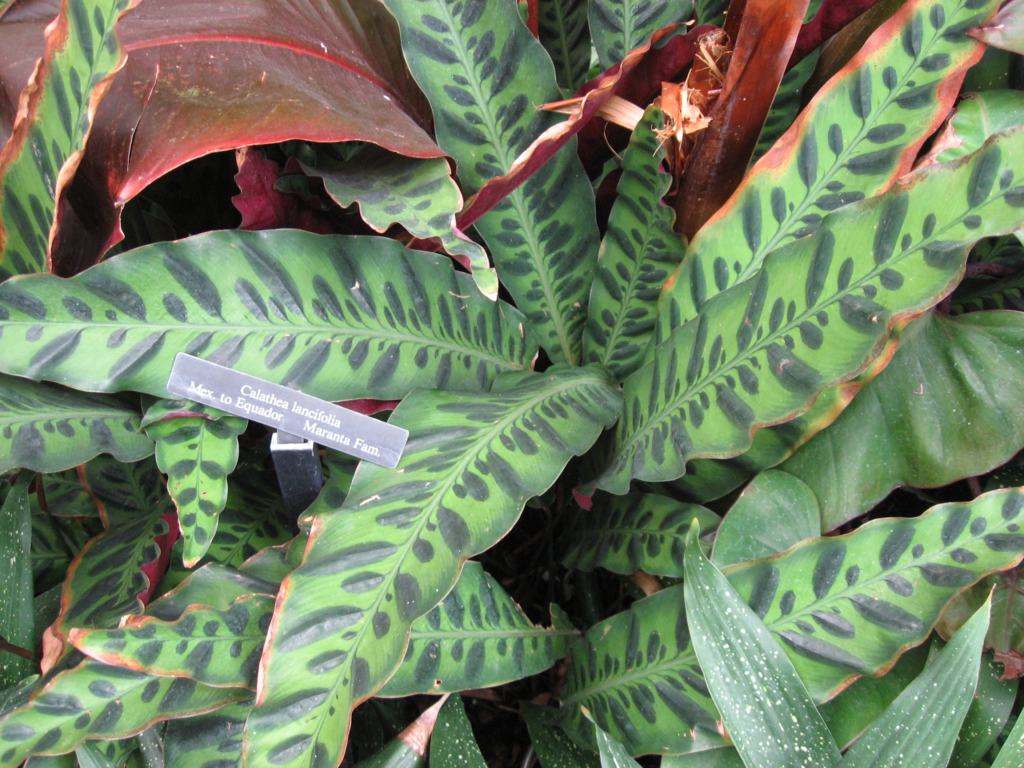
5. Calathea Makoyana (Peacock Plant): The Delicate Beauty
The Calathea makoyana, aptly nicknamed the Peacock Plant, showcases perhaps the most intricate and delicate patterning in the Calathea family. Its translucent, pale green leaves feature feathery dark green markings that radiate from the central vein, creating a pattern reminiscent of peacock feathers. This ethereal quality is enhanced by the leaves’ thinner texture, which allows light to pass through more readily than the thicker leaves of many other Calathea varieties.
What truly distinguishes the makoyana is how dramatically it transforms under different lighting conditions. When backlit, the translucent areas create an almost stained-glass effect as light passes through the leaf tissues. This quality makes strategic placement especially important for showcasing the plant’s full beauty.
Native to eastern Brazil, the makoyana has been cultivated as an ornamental plant since the Victorian era, when it was highly prized in elaborate indoor plant displays. This long history of cultivation has resulted in plants that adapt relatively well to indoor conditions, provided their fundamental needs for humidity and filtered light are met.
In terms of growth habit, the makoyana typically maintains a more open, less densely clustered form than varieties like the medallion. It generally reaches 1-2 feet in height and spread, with individual leaves remaining somewhat smaller and more delicate than those of larger varieties like the orbifolia.
This more refined scale and lighter visual presence make the makoyana particularly well-suited to smaller spaces or more elaborate plant groupings where its delicate patterning provides a contrast to bolder foliage plants.
The Makoyana’s Light Requirements: Finding the Perfect Balance
The makoyana’s translucent qualities create both opportunities and challenges when it comes to light exposure. While its thin leaves can create stunning visual effects when properly illuminated, they’re also more susceptible to sun damage than thicker-leaved varieties.
The ideal location provides bright, indirect light that showcases the leaf pattern without risking scorching. An east-facing window filtered by a sheer curtain often provides this perfect balance. In regions with particularly intense sunlight, positioning the plant a few feet back from even north-facing windows might be necessary during peak summer months.
Some innovative indoor gardeners have incorporated small, directional LED grow lights into their displays to backlight the makoyana’s leaves, creating dramatic evening displays that highlight the plant’s unique translucent qualities. This approach allows you to enjoy the plant’s full beauty even in spaces with limited natural light.

6. Calathea Zebrina (Zebra Plant): The Bold Stripes
The Calathea zebrina, commonly known as the Zebra Plant, features some of the boldest, most dramatic striping patterns in the Calathea genus. Its large, velvety leaves display alternating bands of dark green and light green that radiate from the central vein, creating a vivid zebra-like pattern that gives the plant its common name. The undersides of the leaves maintain the typical Calathea characteristic of rich purple coloration.
What makes the zebrina particularly striking is the velvety texture of its leaves, which adds a tactile dimension to its visual appeal. This soft surface catches and diffuses light differently than smoother-leaved varieties, giving the zebrina a distinctive glow under proper lighting conditions.
The zebrina’s bold patterning makes it an excellent choice for spaces that need a strong visual anchor. Its high-contrast leaves can hold their own even in busier design contexts where more subtle patterns might get lost. This visual strength has made it increasingly popular in maximalist interior design trends across the US market.
In terms of growth habit, the zebrina develops a relatively upright, architectural form. At maturity, it typically reaches 2-3 feet in height with a similar spread. Individual leaves can grow quite large, often reaching 8-12 inches in length, which contributes to the plant’s substantial presence.
While the zebrina shares the general care requirements of other Calatheas, it demonstrates particularly pronounced leaf movement in response to light changes. The daily folding and unfolding of its leaves is more dramatic than in many other varieties, making it an engaging choice for plant enthusiasts who enjoy observing this fascinating nyctinastic response.
The History and Cultural Significance of Zebra Plants
The zebrina has a long history of cultivation dating back to the Victorian era, when it was considered a prestigious addition to indoor plant collections. During this period of intense interest in exotic botanical specimens, the bold patterning of the zebrina represented the height of horticultural fashion.
In its native Brazil, the large leaves were traditionally used for practical purposes similar to those of the lancifolia, including food wrapping and temporary shelters during forest journeys. The plant’s ability to shed water effectively due to its leaf structure made it particularly valuable for these applications.
Today, the zebrina continues this tradition of practical beauty, serving as a striking decorative element while also contributing to improved indoor air quality. Research by environmental scientists at the EPA on indoor air quality highlights the benefits of incorporating tropical foliage plants in interior spaces.
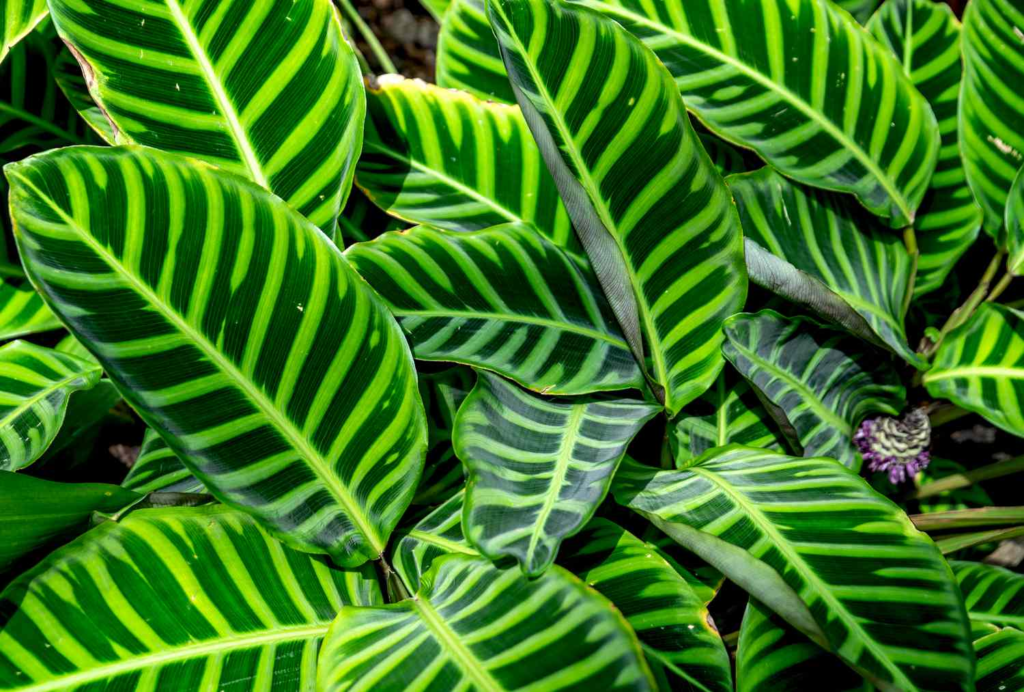
7. Calathea Warscewiczii (Jungle Velvet): The Textural Marvel
Perhaps the most tactilely appealing member of the Calathea family, Calathea warscewiczii—commonly called Jungle Velvet—offers a distinctly different aesthetic from the painted-look patterns of many other varieties. Its elongated, lance-shaped leaves feature a velvety dark green surface with lighter green feathering along the central vein, complemented by deep purple undersides.
What truly distinguishes the warscewiczii is its unique texture. The leaf surface possesses an ultra-soft, velvety quality created by thousands of tiny hairs (trichomes) that give it an almost suede-like appearance and feel. This textural element adds a dimension of sensory experience beyond the purely visual appeal of other Calatheas.
The warscewiczii also stands out for its flowering habit, which is more pronounced than in many other Calathea species grown as houseplants. It produces cone-shaped white bracts with small purple-white flowers that emerge from the center of the plant, adding seasonal interest to its already compelling foliage.
Native to Costa Rica and Nicaragua, this variety has become increasingly available in the US market in recent years, though it remains somewhat less common than varieties like orbifolia or medallion. Its relative scarcity combined with its distinctive appearance has made it a sought-after specimen among serious Calathea collectors.
The warscewiczii typically grows to 2-3 feet in height and spread, with a more upright growth habit than some of the more spreading varieties. This vertical tendency makes it an excellent choice for adding height to plant displays without requiring excessive floor space.
Caring for Jungle Velvet’s Special Needs
The velvety texture that makes warscewiczii so appealing also creates some specific care considerations. The trichomes that form its fuzzy surface can trap dust more readily than smoother-leaved plants, necessitating regular cleaning to maintain both its appearance and photosynthetic efficiency.
Rather than wiping the leaves as you might with smoother Calatheas, the warscewiczii benefits from gentle showering or misting to remove dust without damaging the delicate surface texture. Some enthusiasts use a soft makeup brush to very gently remove dust from the leaf surfaces between more thorough cleanings.
The warscewiczii also demonstrates particularly strong preferences for high humidity, with leaf edges quickly crisping in drier environments. For success with this variety, consistent humidity above 60% is highly recommended, making it an excellent candidate for enclosed terrariums or dedicated plant cabinets where moisture levels can be more precisely controlled.
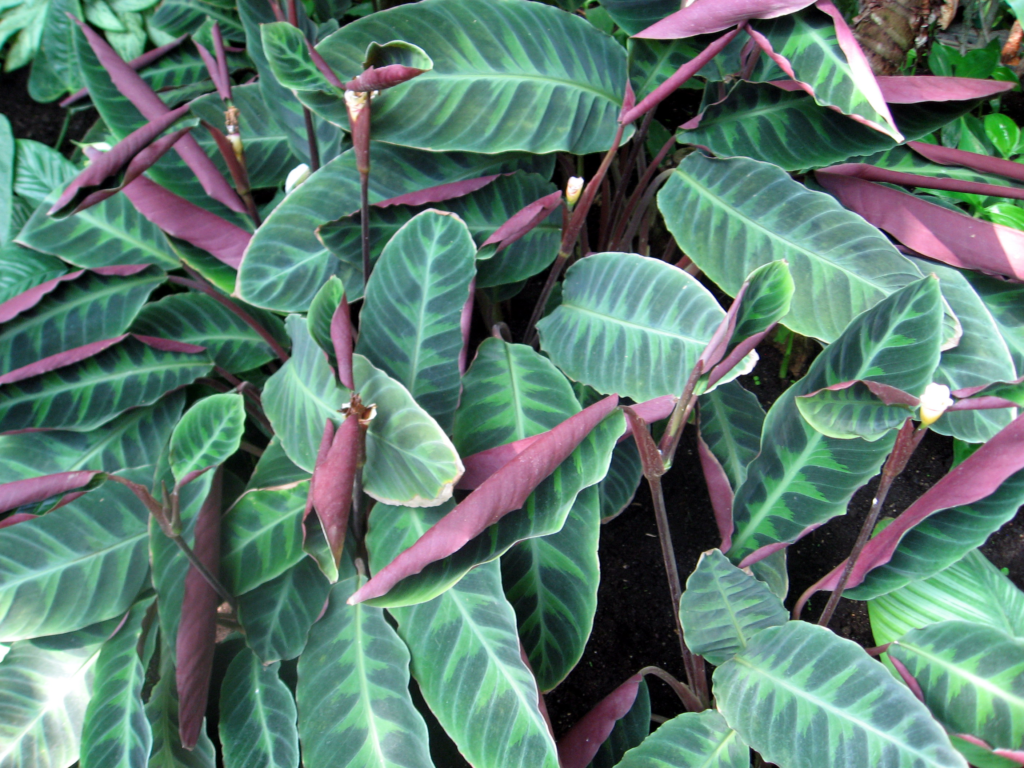
8. Calathea Ornata (Pinstripe Calathea): The Elegant Lines
The Calathea ornata, known as the Pinstripe Calathea, offers perhaps the most precisely patterned leaves in the Calathea family. Its glossy, dark green leaves feature thin, parallel pink or white stripes (depending on the specific cultivar) that radiate from the central vein with remarkable regularity. This mathematical precision creates an almost graphic quality that appeals particularly to those with an appreciation for more structured, less organic-looking patterns.
What makes the ornata especially interesting is how dramatically its appearance can change depending on the specific cultivar and growing conditions. The ‘Sanderiana’ cultivar displays bright pink stripes that create a striking contrast against the dark green background, while other varieties feature more subtle white or light green lines. Light conditions significantly influence the vibrancy of these markings, with brighter indirect light generally intensifying the contrast.
The ornata has gained substantial popularity in the US market partly due to its relatively compact growth habit. Typically reaching 1-2 feet in height and spread, it fits comfortably on shelves, desks, or tabletops where larger varieties might overwhelm the space. This manageable size combined with its distinctive patterning has made it a favorite for smaller urban living spaces.
Like other Calatheas, the ornata performs its daily leaf movements, folding its leaves upward at night to reveal the burgundy undersides. The contrast between the precisely striped upper surfaces and solid-colored undersides creates an ever-changing display throughout the day-night cycle.
The Ornata’s Reputation: Beautiful but Demanding
Within the plant community, the ornata has developed a somewhat challenging reputation. While undeniably beautiful, it’s often considered one of the more temperamental Calathea varieties, being particularly sensitive to water quality and humidity fluctuations.
The thin pink or white stripes tend to brown first when conditions aren’t ideal, making any care mistakes immediately visible. This characteristic has led some to call it the “drama queen” of the Calathea world. However, this sensitivity can also make it an excellent indicator plant – when your ornata looks perfect, you can be confident that your care routine is meeting the high standards required by all Calatheas.
For success with this beautiful but demanding variety, consistency is key. Stable conditions, careful attention to water quality, and proactive humidity management will reward you with the striking, precisely patterned foliage that makes the ornata so desirable despite its challenges.
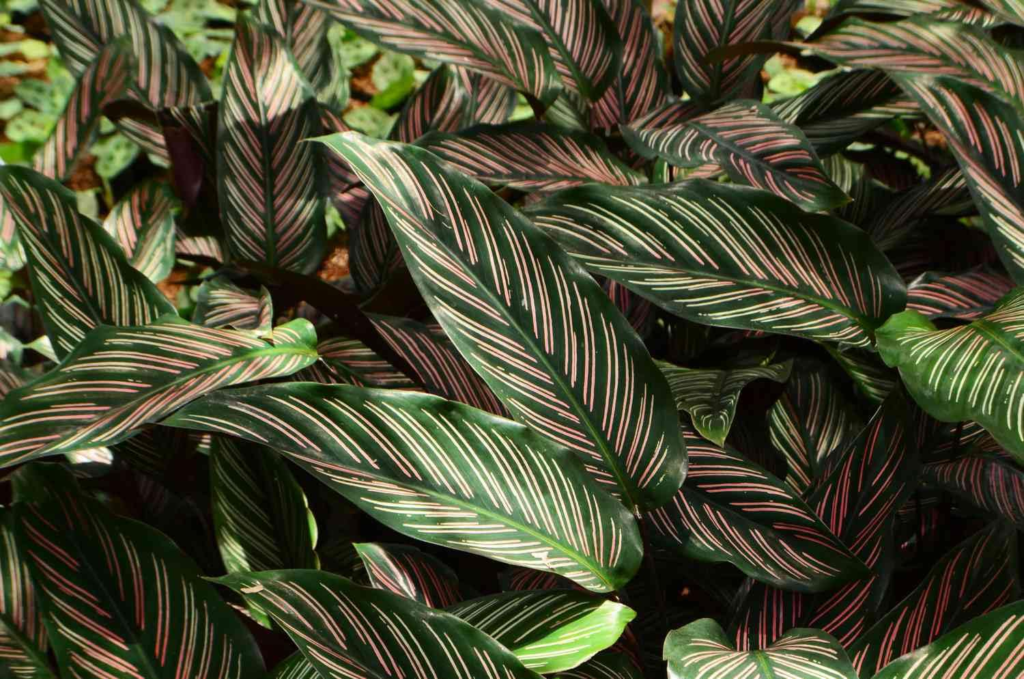
9. Calathea Rufibarba (Furry Feather Calathea): The Unique Texture
The Calathea rufibarba stands out from other Calatheas with its distinctly different leaf shape and texture. Rather than the broad, patterned leaves typical of the genus, the rufibarba features long, narrow leaves with gently wavy edges. The upper surface displays a uniform deep green color without the elaborate patterns found in other varieties, while the undersides reveal a rich burgundy hue.
What truly distinguishes the rufibarba, earning it the common name “Furry Feather Calathea,” is the soft, velvety texture on the underside of each leaf. This fuzzy quality, created by fine hairs covering the leaf surface, adds a tactile dimension to the plant’s appeal and creates interesting light-catching properties as the leaves move throughout the day.
The rufibarba’s leaf movement is particularly pronounced, with its long, narrow leaves rising dramatically at night and flattening horizontally during daylight hours. This dynamic quality, combined with the contrast between green upper surfaces and burgundy undersides, creates an ever-changing display that adds kinetic interest to plant collections.
Native to Brazil, the rufibarba has grown in popularity in the US market partly due to its reputation as one of the more forgiving and adaptable Calathea species. While it still appreciates the high humidity and filtered light preferred by all Calatheas, it tends to be slightly more tolerant of occasional lapses in ideal conditions.
At maturity, the rufibarba typically reaches 2-3 feet in height with a similar spread, creating a full, fountain-like growth habit. The arching, feathery leaves create a graceful silhouette that contrasts effectively with the more structured appearance of many other houseplants.
The Rufibarba’s Practical Advantages
Beyond its aesthetic appeal, the rufibarba offers several practical advantages for indoor gardeners. Its uniform green coloration makes it less susceptible to the browning leaf edges that can occur with more intricately patterned varieties when conditions aren’t perfect.
The long, narrow leaf shape also provides better air circulation around the plant, reducing the risk of fungal issues that can sometimes affect denser, broader-leaved varieties in humid environments. This characteristic makes it particularly well-suited to bathrooms and other naturally humid spaces where proper air movement can be challenging.
For those living in regions with hard tap water, the rufibarba’s greater tolerance for mineral content makes it a more forgiving choice than varieties like orbifolia or ornata, which often develop unsightly spotting when exposed to water containing calcium, fluoride, or chlorine.
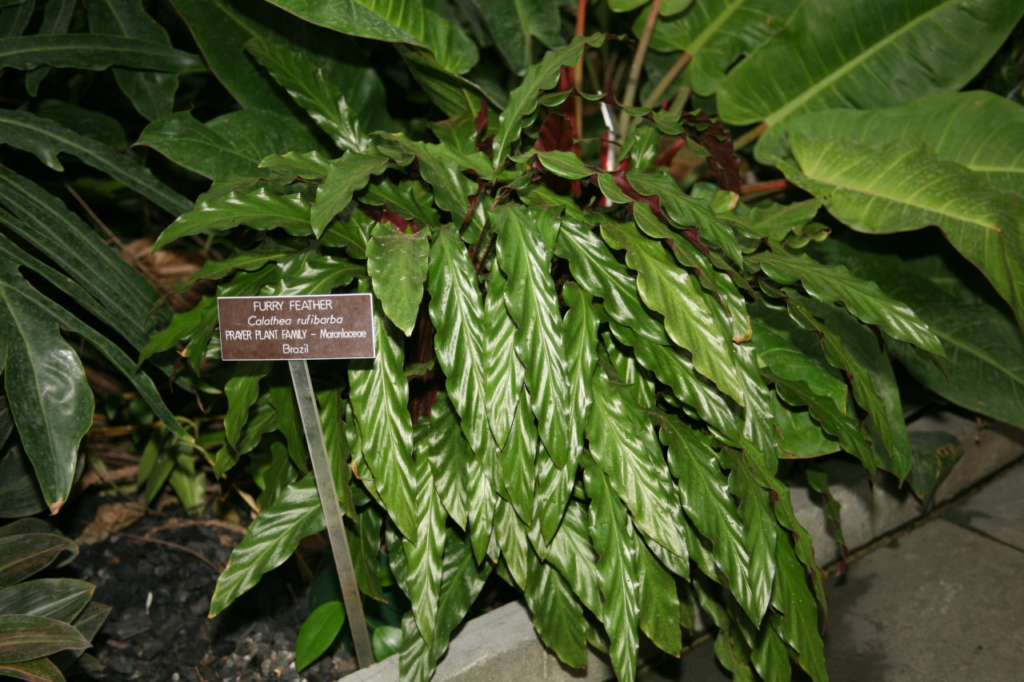
10. Calathea Musaica (Network Calathea): The Intricate Mosaic
Rounding out our collection of stunning Calatheas is perhaps the most intricate of them all: Calathea musaica, now botanically reclassified as Goeppertia kegeljanii ‘Network’ but still widely known by its original name. This remarkable plant features small, rounded leaves covered with an incredibly detailed network of fine lime-green lines arranged in a mosaic-like pattern against a darker green background.
What makes the musaica truly extraordinary is the scale and complexity of its patterning. Unlike the bolder stripes or zones of color seen in other Calatheas, the musaica’s pattern resembles delicate filigree or intricate tile work, with hundreds of tiny lines creating a crackled appearance across each leaf surface. This minute detailing invites closer inspection and creates an entirely different visual effect than any other Calathea variety.
In recent years, the musaica has transitioned from a rare collector’s item to a more widely available but still highly sought-after specimen in the US market. Its popularity stems partly from its unique appearance and partly from its reputation as one of the more resilient Calathea varieties, being somewhat more tolerant of lower humidity and occasional drying than many of its cousins.
The musaica typically grows to 1-2 feet in height and spread, with a dense, bushy growth habit created by numerous small leaves growing in tight clusters. This compact form makes it ideal for tabletops and smaller spaces where its intricate patterning can be appreciated up close.
Unlike some Calatheas with dramatic color contrasts between the upper and lower leaf surfaces, the musaica’s leaves appear nearly identical on both sides, with the same intricate network pattern visible top and bottom. This consistency creates a more uniform appearance regardless of viewing angle.
The Science Behind Musaica’s Unique Pattern
The extraordinary patterning of Calathea musaica represents a fascinating example of how plant pigmentation can create complex visual effects. The pattern results from specialized cells that produce different levels of chlorophyll, creating the contrast between the lighter veins and darker background tissue.
Botanists studying this phenomenon have noted that these intricate patterns likely evolved as camouflage in the dappled light of the forest floor, breaking up the leaf outline to make it less visible to herbivores. This evolutionary adaptation now serves an entirely different purpose, making the plant highly desirable for its ornamental qualities.
Research on plant pattern development at institutions like the United States National Arboretum continues to explore the genetic factors that control these remarkable natural designs, potentially leading to new understanding of how complex biological patterns form.

Comparative Analysis: Choosing Your Perfect Calathea
To help you make an informed decision about which Calathea variety might be best suited to your specific situation, we’ve compiled comprehensive comparison tables highlighting key differences in aesthetics, care requirements, and practical considerations.
Table 1: Visual Characteristics of Calathea Varieties
| Variety | Leaf Shape | Primary Colors | Pattern Type | Special Features | Visual Impact |
|---|---|---|---|---|---|
| Orbifolia | Round, broad | Silver, green | Bold stripes | Largest leaves in group | Dramatic, statement piece |
| Medallion | Round to oval | Green, burgundy | Central medallion | Purple stems | Rich, colorful |
| Roseopicta ‘Dottie’ | Round | Purple-black, pink | Bordered edges | Highest contrast | Gothic, dramatic |
| Lancifolia | Long, lance-shaped | Light and dark green | Alternating spots | Wavy leaf edges | Wild, organic |
| Makoyana | Oval | Pale and dark green | Feathered veins | Translucent qualities | Delicate, ethereal |
| Zebrina | Broad, oval | Light and dark green | Bold zebra stripes | Velvety texture | Strong, graphic |
| Warscewiczii | Elongated, lance-shaped | Dark green, light feathering | Central vein highlight | Ultra-velvety, flowers regularly | Textural, sophisticated |
| Ornata | Oval | Dark green, pink/white | Thin, precise stripes | Mathematical precision | Elegant, structured |
| Rufibarba | Long, narrow | Green, burgundy | Solid colored | Furry undersides | Tactile, movement-focused |
| Musaica | Small, round | Lime and dark green | Intricate network | Mosaic-like detailing | Complex, fascinating |
Table 2: Care Requirements Comparison
| Variety | Humidity Needs | Light Sensitivity | Water Sensitivity | Resilience | Beginner-Friendly Rating (1-10) |
|---|---|---|---|---|---|
| Orbifolia | Very High | Moderate | High | Moderate | 5 |
| Medallion | High | Moderate | High | Moderate | 6 |
| Roseopicta ‘Dottie’ | High | High | High | Moderate | 4 |
| Lancifolia | Moderate to High | Low | Moderate | High | 8 |
| Makoyana | High | Very High | High | Low | 5 |
| Zebrina | High | Moderate | Moderate | Moderate | 7 |
| Warscewiczii | Very High | Moderate | High | Low | 3 |
| Ornata | Very High | Moderate | Very High | Low | 3 |
| Rufibarba | Moderate to High | Low | Moderate | High | 8 |
| Musaica | Moderate to High | Low | Moderate | High | 7 |
Table 3: Practical Considerations for Different Living Environments
| Variety | Mature Size | Growth Rate | Space Needs | Best Room Placement | Compatibility with Pets |
|---|---|---|---|---|---|
| Orbifolia | 2.5 ft tall and wide | Slow | Large | Living room, bedroom | Non-toxic |
| Medallion | 1-2 ft tall and wide | Moderate | Medium | Office, living room | Non-toxic |
| Roseopicta ‘Dottie’ | 12-20 inches | Slow to moderate | Small to medium | Bedroom, office | Non-toxic |
| Lancifolia | 24-30 inches tall | Moderate | Medium, vertical | Bathroom, kitchen | Non-toxic |
| Makoyana | 1-2 ft tall and wide | Moderate | Medium | Bathroom, bedroom | Non-toxic |
| Zebrina | 2-3 ft tall and wide | Moderate | Large | Living room, enclosed porch | Non-toxic |
| Warscewiczii | 2-3 ft tall | Slow to moderate | Medium, vertical | Bathroom, enclosed terrarium | Non-toxic |
| Ornata | 1-2 ft tall and wide | Slow | Small to medium | Office, bedroom | Non-toxic |
| Rufibarba | 2-3 ft tall and wide | Moderate to fast | Medium to large | Bathroom, kitchen | Non-toxic |
| Musaica | 1-2 ft tall and wide | Slow to moderate | Small to medium | Office, living room | Non-toxic |
Table 4: Market Availability and Investment Considerations
| Variety | Relative Cost | Availability in US Market | Long-term Value | Propagation Ease | Collection Status |
|---|---|---|---|---|---|
| Orbifolia | High | Widely available | Stable, increasing | Moderate | Common flagship variety |
| Medallion | Moderate | Very common | Stable | Moderate | Essential collection starter |
| Roseopicta ‘Dottie’ | Moderate to high | Increasingly common | Increasing | Moderate | Trending variety |
| Lancifolia | Low to moderate | Very common | Stable | Easy | Classic beginner variety |
| Makoyana | Moderate | Common | Stable | Moderate | Classic collection variety |
| Zebrina | Moderate | Common | Stable | Moderate | Classic statement piece |
| Warscewiczii | High | Less common | Increasing | Difficult | Collector’s item |
| Ornata | Moderate | Common | Stable | Difficult | Challenging beauty |
| Rufibarba | Moderate | Increasingly common | Stable | Easy | Rising in popularity |
| Musaica | High | Moderately available | Increasing | Moderate | Highly sought collector’s item |
Troubleshooting Common Calathea Challenges
Even with the best care, Calatheas sometimes present challenges. Understanding how to address these issues can help you maintain your plants’ health and beauty for years to come.


